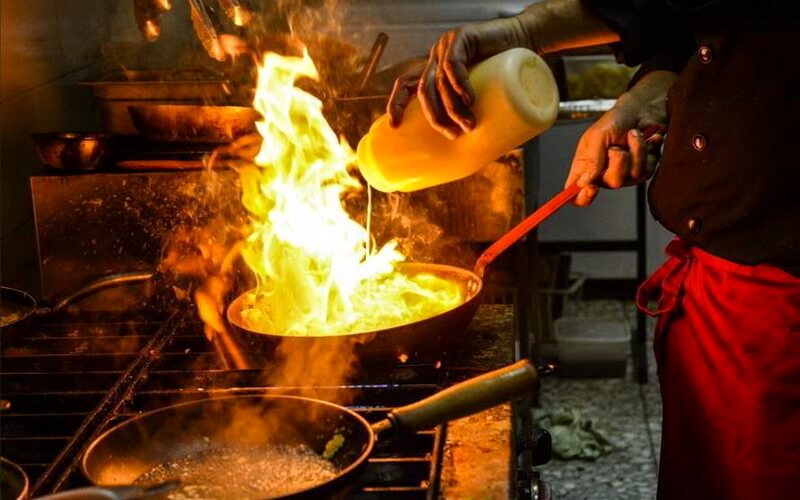Why Avoid High Temperature Cooking?
Food cooked at high temperatures may be handy and quick, and it may fill the air with savory odors, but it comes at a nutritional cost. Neither the foods nor the nutrients they contain were designed to withstand extremely high temperatures. How you prepare your foods is just as essential to your health as what you eat.

Unwanted Consequences of High-Heat Cooking
Loss of nutrients
The problems with high-heat cooking are not restricted to the creation of toxic substances. High-heat cooking is also problematic when it comes to the loss of nutrients. Virtually all nutrients in food are susceptible to damage from heat. Of course, whether a particular nutrient gets damaged depends on the exact nutrient in question, the degree of heat, and the amount of cooking time. But in general, most of the temperatures we cook at in the oven (250–450°F/120–230°C) are temperatures at which substantial nutrient loss occurs, except for roasting turkey because it takes a long time for the heat to penetrate the meat and damage the nutrients. And although very short cooking at 212°F (100°C) in boiling water produces relatively little nutrient loss, once boiling goes on for anything more than a very short period of time (1–3 minutes), the nutrient loss becomes significant.
Heterocyclic amino acids (HCAs) and polycyclic aromatic hydrocarbons (PAHs)
When meat, especially red meat, is cooked at high temperatures, HCAs and PAHs can form. We've learned, for example, that some of the most mutagenic agents formed in cooking, heterocyclic amines (HCAs), are commonly found in barbecued beef, chicken, and pork cooked at 392°F (200°C) or above. We even know what basic ingredients are required for these mutagenic agents to be produced: high temperature for more than a few minutes, free amino acids (from protein), creatine (or creatinine), and sugar. Without the high-temperature component, the formation of HCAs does not occur. Direct flame grilling produces another type of carcinogen called polycyclic aromatic hydrocarbons (PAHs), which might be just as harmful as the HCAs.
Since most of the research on HCAs has been done on meat, it is uncertain that the grilling of vegetables and fruits may have the same level of outcomes, notably because some of the phytonutrients found in vegetables, such as the sulforaphane in broccoli, have been found to reduce the carcinogenic effect of the HCAs in research studies.
Tips: These compounds have been linked to an increased risk of cancer. To minimize this risk, you can marinate meat before grilling, flip it frequently, and avoid overcooking.
Advanced Glycation End Products (AGEs)
Research found that foods cooked at high temperatures contain greater levels of compounds called advanced glycation end products (AGEs) that cause more tissue damage and inflammation than foods cooked at lower temperatures. AGEs irritate cells in the body, damaging tissues and increasing your risk of complications from diseases like diabetes and heart disease. Cooking meals at lower temperatures by steaming, sautéing, or poaching is a good way to avoid these chemicals. You can also cook meats with foods that contain antioxidant bioflavonoids, like garlic, onion, and pepper.
Tips: To reduce AGE formation, consider using acidic marinades and incorporating more vegetables into your grilled dishes.
Acrylamide
Research has discovered that a potentially toxic substance called acrylamide, which is a carcinogenic nerve-damaging compound, is also formed when certain foods are cooked at high temperatures. such as potato chips,flaked breakfast cereals, roasted nuts, and some other foods. As is the case with HCAs, acrylamide does not appear to form when high cooking temperatures are absent.
Food Safety
Heat is important in cooking because it can kill bacteria that can contaminate foods, especially meats and fish. The time required to kill bacteria decreases as the temperature increases. Eradication of bacteria starts at about 165°F (74°C), but as you move upward from this temperature, the time it takes to kill bacteria shortens. For some foods, like thick cuts of meat or fish, it is important to cook for however long it takes to produce a certain internal core temperature. In general, however, it takes much less than 5 minutes to kill potentially harmful bacteria on most plant foods.
Vegetables and high-heat cooking
When it comes to vegetables, sensitivity to high heat has to be measured in a matter of minutes! In some foods, like Swiss chard, the loss of vitamin C can increase by 15% in a matter of just 4–5 minutes. Green beans will steam in about 5 minutes. During this time, their color will take on a more vibrant green hue. If you cook it longer, you will notice a change in color. For example, after 7 minutes, a drop in color intensity will begin to occur. By 9 or 10 minutes, the color intensity will have dropped noticeably. Just 2–3 minutes of extra steaming time can make this notable difference.
The optimal timetable for high-heat cooking will vary depending on a number of factors, in addition to the type of vegetable. How the vegetable is sliced, for example, will change the amount of steaming it needs. Finely shredded cabbage requires less steaming and less heat than coarsely shredded cabbage. Because more of the surface of the finely shredded cabbage gets directly exposed to the steam, it takes less time for the cabbage to become tender. If you mix vegetables in the steamer basket, the topmost layers that are less directly exposed to the steam should be the vegetables needing the least steaming. The vegetables requiring longer steaming should be placed on the bottommost layer. Alternatively, vegetables that need less steaming can be added to the steamer basket later on, after the vegetables that are thicker and more dense have been added.